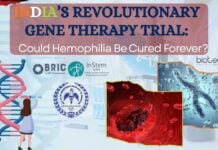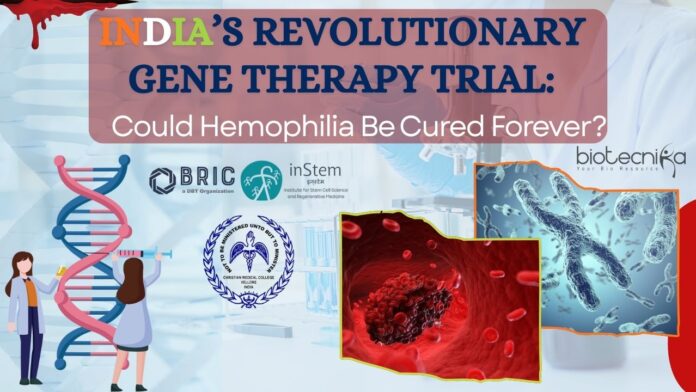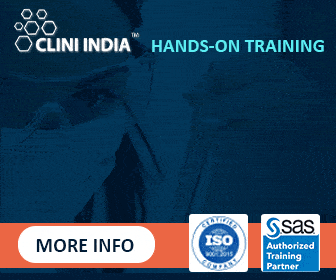India’s Revolutionary Gene Therapy Trial: Could Hemophilia Be Cured Forever?
Have you ever wondered if a single medication could end a lifelong struggle for several patients? What if the cure for a genetic disorder such as Hemophilia could finally be with us? This isn’t a visionary dream world, but it’s happening now in India!
In an extraordinary innovative effort, India has launched its first-ever “Human Gene Therapy” trial for ‘Hemophilia.’ This is a big hope and relief for our future, where such a Genetic condition could finally be treated and cured! But what do you think this futuristic development means for the Heathcare sector’s future? Do you think this could revolutionize Genetic Disorders treatments forever? The answers might surprise you!
India has achieved a significant milestone in Biotechnology, with the successful and triumphant launch of its first Human Gene Therapy trial for Hemophilia. This achievement was possible due to the partnership between CMC (Christian Medical College) Vellore and the BRIC-inStem (Biotechnology Research and Innovation Council’s Institute for Stem Cell Science and Regenerative Medicine) in Bengaluru. The launch announcement was made on 25th April 2025, highlighting a significant advancement in India’s capabilities in Gene Therapy for Genetic Disorders.
Shri. Jitendra Singh , Union Science and Technology Minister, visited the BRIC-inStem to review the progress of the Human Gene Therapy trial and further praised the collaborative effort between the two institutions. He stated, “This is a milestone in India’s scientific journey,” stressing the far-reaching impact of this trial, in medical research as well as for India’s future in the Healthcare sector.
India’s Revolutionary Gene Therapy Trial
The Need for Gene Therapy
Hemophilia is a rare Genetic disorder, generally where the blood doesn’t clot, leading to prolonged and excessive bleeding after even a minor injury. A Haemophilic person lacks a coagulation factor (mostly Coagulation Factor VIII or Coagulation Factor IX) and is hereditary in nature. Conventional treatments for Hemophilia involve regular infusions of clotting factor proteins, which require lifelong management and are expensive as well. Gene Therapy, on the other hand, aims to rectify the Genetic mutation at the root of the disease, offering a potential cure by providing a lasting solution to patients, eliminating the need for ongoing treatments. With Gene Therapy, the body receives a functional copy of the defective or missing coagulation factor Gene, i.e., Coagulation Factor VIII for Hemophilia-A and Coagulation Factor IX for Hemophilia-B.
This Human Gene Therapy trial is an important step towards the application of Gene Therapy to treat hemophilia and is the first of its kind in India. Esteemed Researchers at CMC Vellore and BRIC-inStem believe that this development will lead to more permanent as well as accessible treatment options for Hemophilic patients who have been suffering for ages.
Union Minister’s Remarks on India’s Revolutionary Gene Therapy Trial
Shri Jitendra Singh appreciated the work of BRIC-inStem as well as its role in advancing the future of Regenerative Healthcare. During his special visit, he emphasized that this trial’s representation is more than a mere Scientific achievement. He said that this achievement reflects India’s growing influence in the Biotechnology sector worldwide. He stated, “This is a milestone in India’s scientific journey. This is not just about science; it’s about nation-building,” highlighting how the Biotechnology field has become a core part of India’s Development strategy.
He also emphasized the role of the Government in nurturing the field of Biotechnology through several policies designed to enhance and encourage growth as well as innovation. He mentioned that ‘India’s Biotechnology sector has expanded over 16-fold in the past decade, with an estimated market value of $165.7 billion in 2024, and is projected to grow to $300 billion by the year 2030.’ He further added that these numbers are a testament to the Policy Reforms that have been implemented to support the Biotechnology sector.
He further mentioned, “We now have over 10,000 biotech startups compared to just 50 a decade ago,” pointing out the rapid expansion of the industry and its potential for improving public health as well as driving economic growth.
A Step Towards a Healthier Future via India’s Revolutionary Gene Therapy Trial
During his visit to BRIC-inStem’s facilities, Singh also visited the Biosafety Level III laboratory, which is critical for studying high-risk pathogens. The laboratory plays a key role in India’s preparedness against global health threats and is part of the One Health Mission, which focuses on integrating human, animal, and environmental health. Singh stated, “The pandemic taught us that we must always be prepared. Facilities like this will help us stay a step ahead”, and highlighted the importance of maintaining such facilities, especially in light of the lessons learned from the COVID-19 pandemic.
Moreover, he praised the newly established CReATE (Centre for Research Application and Training in Embryology), which focuses on addressing infertility as well as birth defects. He said that the centre’s research is vital for improving maternal and neonatal health outcomes, an area of great concern given that 3-4% of babies are born with some form of congenital defect.
India’s Biotechnology Strategy
Minister Singh’s visit reinforced the importance of integrating scientific research with clinical application. He called for greater collaboration between scientific institutions like
BIRC-inStem as well as medical colleges, explain that the educational organisations are exploring MD-PhD programs to bridge the gap between clinical practice and research. These collaborations accelerate translating scientific innovations into practical medical solutions for patients.
“As Mark Twain said, the economy is too serious a subject to be left to economists alone. Biotechnology is not just a science anymore — it is a pillar of our national strategy,” Singh remarked, emphasizing that the field of Biotechnology has now become a critical part of India’s growth story, with implications for both public health as well as the economy.
The Gene Therapy Process for Hemophilia
The new Gene Therapy for Hemophilia involves using vectors, like AAV (Adeno-Associated Viruses), to transfer a functional copy of the missing or defective clotting factor gene to the patient’s cells. The prime aim of the process is to produce the clotting factor in the patient’s body, potentially giving a long-term, if not permanent, solution to the disease.
The trial conducted by BRIC-inStem and CMC, Vellore targets Hemophilia A, which is caused by a deficiency in Factor VIII. The researchers employ a vector-based gene delivery system to introduce the correct version of the Factor VIII gene into the patient’s liver cells, where clotting factors are naturally produced. By achieving this, the therapy aims to reduce or eliminate the need for ongoing factor infusions.
This futuristic and innovative approach marks a significant departure from conventional treatments, offering hope for a permanent solution to a condition requiring constant medical intervention.
Clinical Trial Phases and Next Steps
Hemophilia Gene Therapy is currently in its early stages, likely in Phase I, which mainly focuses on safety as well as dosing. Pervious phase trials are crucial to assess how the therapy is tolerated by the patients as well as to identify any side effects. As the trial progresses, the next stages, Phase II as well as III, will evaluate the therapy’s efficacy and long-term effects, gradually determining its suitability for widespread clinical use.
Researchers are optimistic that successful outcomes in this trial could lead to wider clinical applications. The hope is that, with time, this Gene Therapy could potentially provide a permanent cure for Hemophilia, offering patients an alternative to lifelong treatments. However, significant follow-up studies and monitoring will be required to assess the therapy’s effectiveness and safety over the long term.
The results of this research trial could redefine the healthcare treatment landscape for hemophilia as well as other genetic disorders, bringing India to the forefront of cutting-edge medical innovations. The long-term impact of this research could also influence global Healthcare practices, as India’s Biotechnology companies continue to grow as well as to contribute to global health advancements.
Conclusion: A Promising Future for Hemophilia Treatment
The launch of India’s first Human Gene Therapy trial for Hemophilia is a landmark achievement highlighting the country’s growing capabilities in Biotechnology and Medical Research. The collaboration between BRIC-inStem and CMC, Vellore, is not only advancing Gene Therapy but also positioning India as a significant player in global Biotechnology innovation.
While the trial is still in its early stages, researchers are optimistic that successful outcomes could lead to wider clinical applications and possibly an effective cure for Hemophilia within the next few years. With continued Government support, Policy Reforms, as well as research initiatives, India is poised to lead in the global Biotechnology space, bringing innovative solutions to address critical health challenges both within the country and worldwide!



























